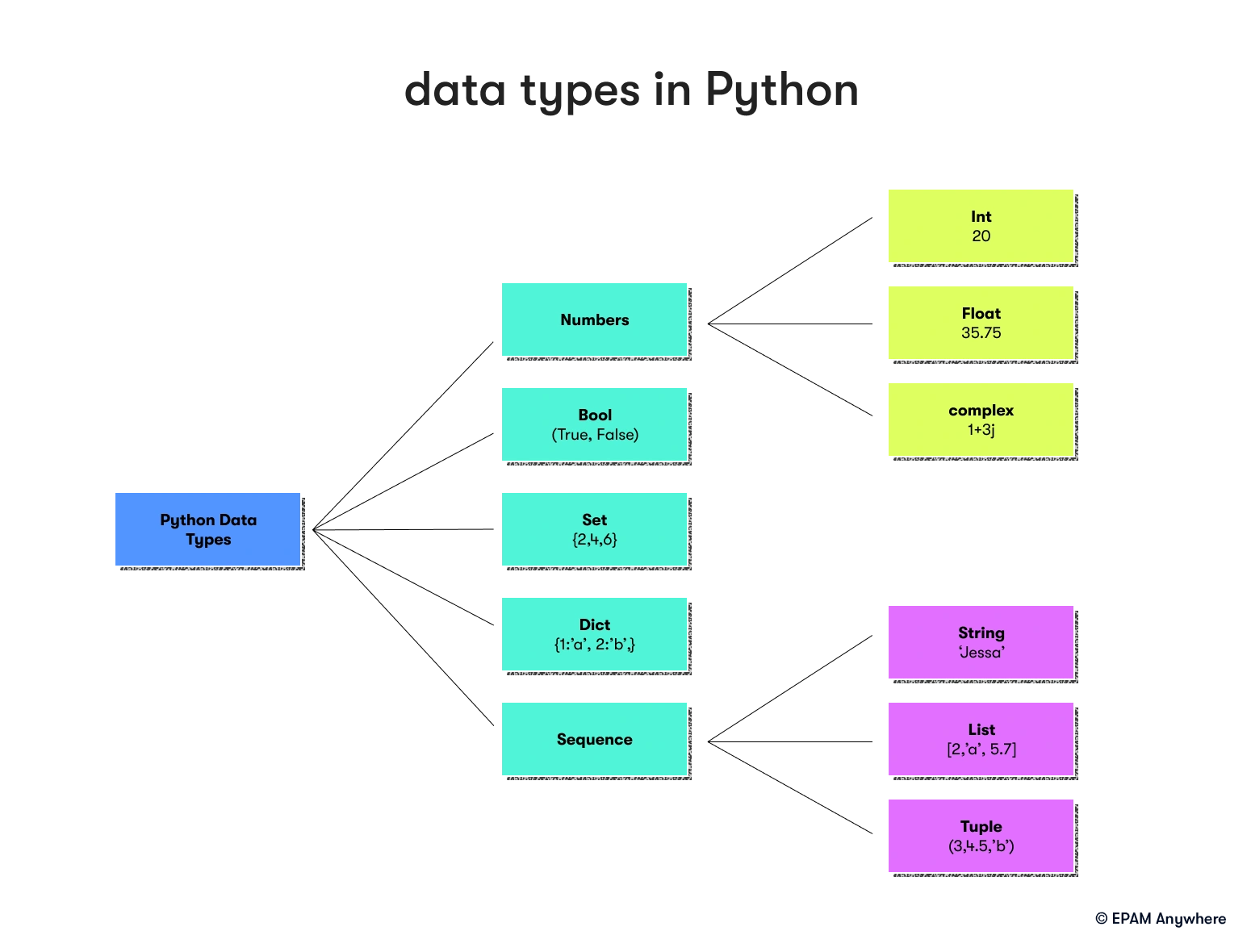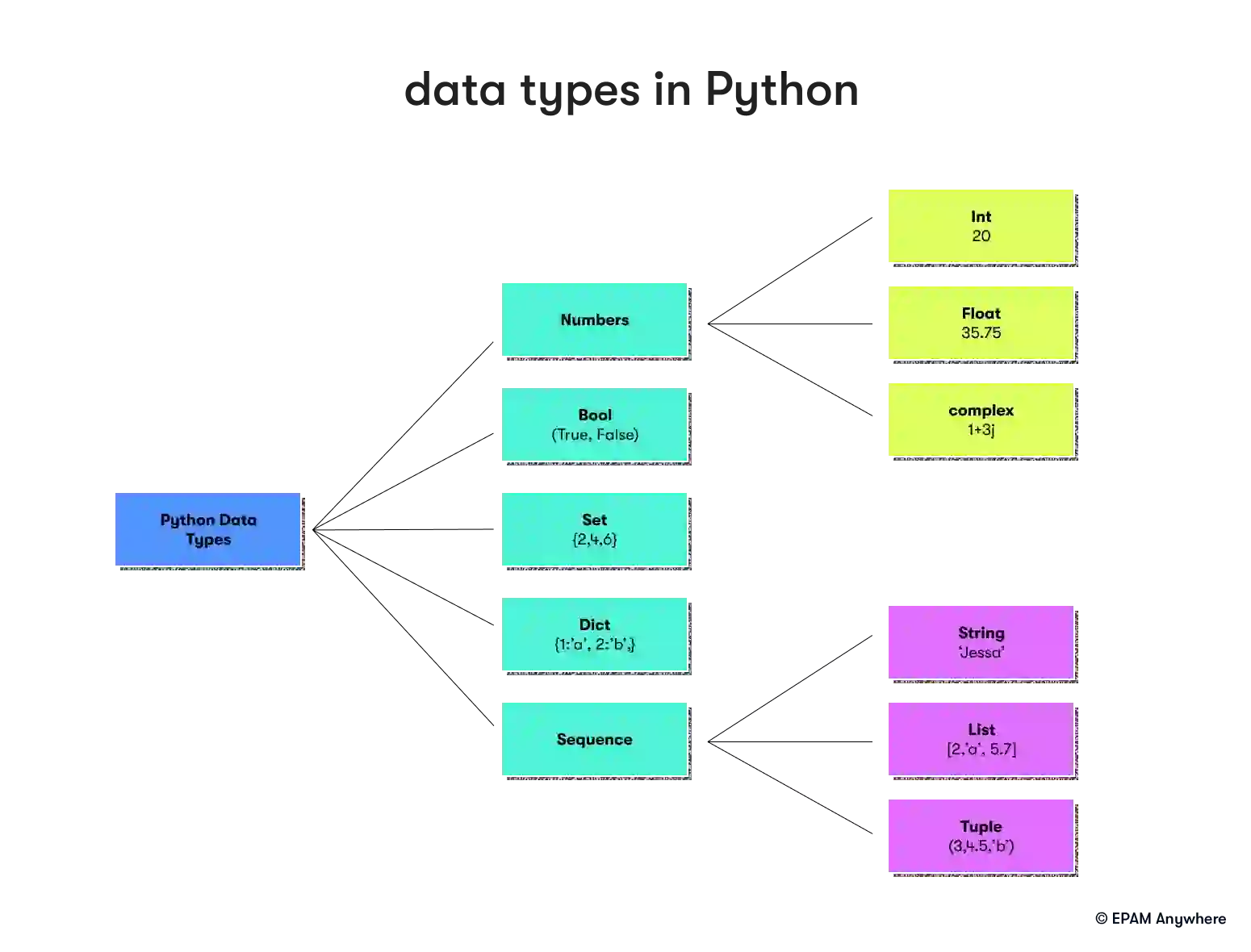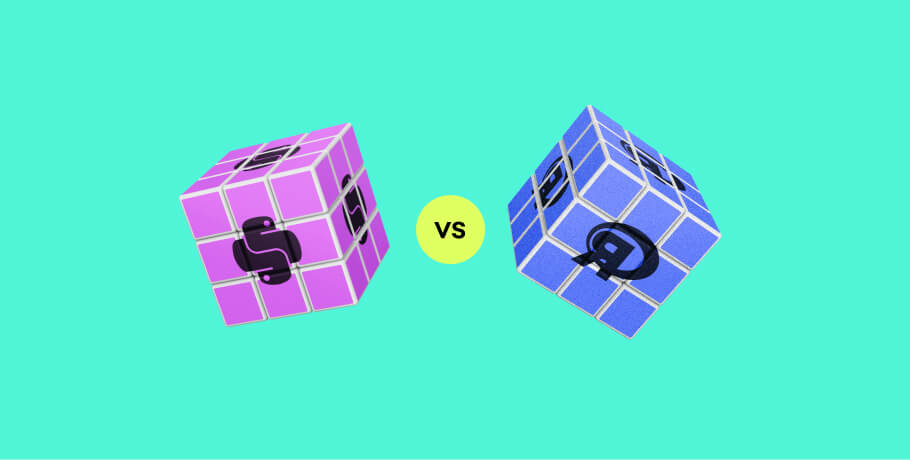This article has been reviewed and verified by EPAM Anywhere’s Python team managed by Denis Berezovskiy, Senior Engineering Manager. Thank you, guys!
Are you preparing for a Python interview and looking to showcase your skills to secure a remote Python developer job? Look no further! We've compiled an extensive list of Python interview questions that will challenge your understanding of the language and help you stand out from the competition.
From basic concepts to advanced topics, these questions cover a wide range of Python features and best practices. Whether you're a beginner or an experienced programmer, this comprehensive guide will help you brush up on your Python knowledge and boost your confidence for the big day.
As a senior Python developer, you might be asked various questions during an interview. Let’s start with 10 basic Python coding questions you may encounter. Dive in and ace that tech interview!
ready to make your next career move?
Send us your CV and we'll get back to you with a matching remote Python job at EPAM Anywhere
1. What are the key features of Python?
Python is a high-level, interpreted, and general-purpose programming language. Some of its key features include:
- Easy-to-read syntax
- Dynamically typed
- Easy to learn for beginners
- Object-oriented, procedural, and functional programming paradigms
- Extensive standard library
- Cross-platform compatibility
- Strong community support
2. What are the differences between Python 2 and Python 3?
Python 2 and Python 3 are two major versions of the language. Unlike Python 3, Python 2 is no longer supported starting from 2020.
Some of the main differences between them are:
- Print function: In Python 2, print is a statement, while in Python 3, it is a function.
- Division: In Python 2, the division of integers results in an integer, while in Python 3, it results in a float.
- Unicode support: Python 3 has better Unicode support with all strings being Unicode by default.
- xrange() function: In Python 2, xrange() is used for efficient looping, while in Python 3, range() serves the same purpose and xrange() is removed.
3. What are Python data types?
Python has several built-in data types, including:
- Numeric: int, float, complex
- Sequence: list, tuple, range
- Text: str
- Mapping: dict
- Set: set, frozenset
- Boolean: bool
- Binary: bytes, bytearray, memoryview

4. How do you create a function in Python?
To create a function in Python, use the `def` keyword followed by the function name and parentheses containing any input parameters. For example:
5. What is the difference between a list and a tuple in Python?
Lists and tuples are both sequence data types in Python. The main differences between them are:
- Lists are mutable, meaning their elements can be changed, while tuples are immutable.
- Lists use square brackets `[]`, while tuples use parentheses `()`.
- Lists generally have a variable length, while tuples have a fixed length.
6. What are list comprehensions in Python?
List comprehensions are a concise way to create lists in Python. They consist of an expression followed by a `for` loop inside square brackets. For example, this is how you create a list of squares of numbers from 0 to 9:
7. What is the difference between `==` and `is` in Python?
`==` is an equality operator that compares the values of two objects, while `is` is an identity operator that checks if two objects are the same in memory. For example:
8. What is a lambda function in Python?
A lambda function is an anonymous, single-expression function that can be used as an inline function. It is defined using the `lambda` keyword, followed by input parameters, a colon, and an expression. For example:
9. How do you handle exceptions in Python?
In Python, you can handle exceptions using the try, except, else, and finally blocks. The try block contains the code that might raise an exception, while the except block catches and handles the exception. The optional else block is executed if no exception is raised in the try block, and the finally block, also optional, is executed regardless of whether an exception occurs or not. Here's an example:
10. What are function decorators in Python?
Decorators are functions that modify the behavior of other functions or methods without changing their code. They are applied using the `@decorator` syntax above the function definition. For example:
11. What is the global interpreter lock (GIL) in Python?
The global interpreter lock (GIL) is a mutex that protects access to Python objects, preventing multiple threads from executing Python bytecodes concurrently in the same process. This lock is mandatory because CPython's memory management is not thread-safe. GIL has some advantages, including the increased performance of single-threaded programs and the ability to easily integrate non-thread-safe C libraries into Python code. However, the GIL can limit the performance of CPU-bound and multithreaded programs in Python.
12. What are context managers and the `with` statement in Python?
Context managers are objects that define a context for a block of code, commonly allowing you to manage resources such as file handles, sockets, and database connections. They are typically used with the `with` statement to ensure that the resources are properly acquired and released. Context managers implement the `__enter__()` and `__exit__()` methods. For example:
It is worth mentioning that the open function in Python is a built-in function that returns a file object, which can be used as a context manager. Internally, the open function uses the io module to create a file object. The file object implements the context manager protocol by defining the __enter__() and __exit__() methods.
Here's a simplified example of how the open context manager could be implemented internally:
In this example, the SimpleFile class is a simplified version of the file object returned by the open function. The __enter__() method opens the file and returns the file object, while the __exit__() method closes the file when the with block is exited. This ensures that the file is properly closed even if an exception occurs within the block.
13. What are metaclasses in Python?
Metaclasses are classes that define the behavior of other classes. In Python, a metaclass is responsible for creating, modifying, and initializing classes. By default, the `type` class is the metaclass for all classes in Python. You can create custom metaclasses by subclassing `type` and overriding its methods.
14. What is the difference between `*args` and `**kwargs` in Python?
`*args` and `**kwargs` are special syntax in Python for passing a variable number of arguments to a function. `*args` is used to pass a variable number of non-keyword (positional) arguments, while `**kwargs` is used to pass a variable number of keyword arguments. For example:
15. How can you use unpacking/starred expressions (*) to assign multiple values to a variable and pass them as separate arguments to a function?
In Python, you can use unpacking/starred expressions (*) to assign multiple values to a single variable. This is particularly useful when you want to extract specific elements from a sequence and group the remaining elements together. After unpacking the values, you can pass them as separate arguments to a function using the same starred expression. Here's an example:
16. What is the difference between shallow and deep copying in Python?
Shallow copying creates a new object and inserts references to the original elements. Deep copying creates a new object and recursively inserts copies of the original elements. The `copy` module provides the `copy()` function for shallow copying and the `deepcopy()` function for deep copying.
17. What are Python's generators and the `yield` keyword?
Generators are special types of iterators that allow you to iterate over a potentially infinite sequence of items without storing them in memory. They are defined using functions that contain the `yield` keyword. When a generator function is called, it returns a generator object without executing the function. The function is only executed when the generator's `__next__()` method is called. The method can be called a) directly, b) using a built-in function next() or c) via a loop. For example:
Generator object's inner state is saved between calls: each time __next__() is called, the generator object resumes from the last yield keyword and stops on the next yield, returning the value.
18. What is the difference between `__str__` and `__repr__` in Python?
`__str__` and `__repr__` are special methods in Python that define human-readable and unambiguous string representations of an object, respectively. Typically, __str__ is regarded as "user-oriented" and __repr__ is regarded as "programmer-oriented". The `__str__` method is called by the `str()` function and the `print()` function, while the `__repr__` method is called by the `repr()` function and the interactive interpreter. If `__str__` is not defined for a class, Python will use `__repr__` as a fallback. Example:
19. What are Python's descriptors?
Descriptors define how attributes are accessed, modified, and deleted in a class. They implement one or more of the special methods `__get__`, `__set__`, and `__delete__`. Descriptors are typically used to implement properties, methods, and class methods in Python.
20. What is the difference between `staticmethod`, `classmethod`, and instance methods in Python?
- `staticmethod`: A static method is a method that belongs to a class rather than an instance of the class. It does not have access to instance or class variables and is defined using the `@staticmethod` decorator.
- `classmethod`: A class method is a method that belongs to a class and has access to class variables. It takes a reference to the class as its first argument and is defined using the `@classmethod` decorator.
- Instance method: An instance method is a method that belongs to an instance of a class and has access to instance variables. It takes a reference to the instance as its first argument (usually named `self`).
Basic Python coding questions
21. What is the difference between `__new__` and `__init__` in Python?
`__new__` and `__init__` are special methods in Python that are involved in the object creation process. `__new__` is responsible for creating and returning a new instance of the class, while `__init__` is responsible for initializing the instance after it has been created. At the beginning the `__new__` method is called and then `__init__` is called. In most cases, you only need to override `__init__`.
22. What is the purpose of the `__call__` method in Python?
The `__call__` method is a special method in Python that allows an object to be called as a function. When an object is called as a function, the `__call__` method is executed. This can be useful for creating objects that behave like functions, such as decorators or function factories.
23. What is the purpose of the `__slots__` attribute in Python?
The `__slots__` attribute defines a fixed set of attributes for a class, which can improve memory usage and performance for classes with many instances. When `__slots__` is defined, Python uses a more efficient data structure for storing instance attributes instead of the default dictionary.
24. What is the difference between `iter()` and `next()` functions in Python?
The `iter()` function is used to obtain an iterator from an iterable object, while the `next()` function retrieves the next item from an iterator. When the iterator is exhausted, the `next()` function raises a `StopIteration` exception.
25. What is the purpose of the `collections` module in Python?
The `collections` module provides specialized container datatypes that can be used as alternatives to the built-in containers (list, tuple, dict, and set). Some of the most commonly used classes in the `collections` module are `namedtuple`, `deque`, `Counter`, `OrderedDict`, and `defaultdict`.
26. What is the purpose of the `functools` module in Python?
The `functools` module provides higher-order functions and tools for working with functions and other callable objects. Some of the most commonly used functions in the `functools` module are `partial`, `reduce`, `lru_cache`, `total_ordering`, and `wraps`.
27. What is the purpose of the `itertools` module in Python?
The `itertools` module provides a collection of fast, memory-efficient tools for working with iterators. Some of the most commonly used functions in the `itertools` module are `count`, `cycle`, `repeat`, `chain`, `compress`, `dropwhile`, `takewhile`, `groupby`, and `zip_longest`.
28. What is the purpose of the `os` and `sys` modules in Python?
The `os` module provides a way to interact with the operating system, such as file and directory management, process management, and environment variables. The `sys` module provides access to Python's runtime environment, such as command-line arguments, the Python path, and the standard input, output, and error streams.
29. What is the purpose of the `pickle` module in Python?
The `pickle` module is used for serializing and deserializing Python objects, allowing you to save and load objects to and from disk. The `pickle` module provides the `dump()` and `load()` functions for writing and reading pickled objects, respectively.
30. What is the purpose of the `re` module in Python?
The `re` module supports regular expressions in Python, allowing you to search, match, and manipulate strings based on patterns. Some of the most commonly used functions in the `re` module are `match`, `search`, `findall`, `finditer`, `sub`, and `split`.
31. What is the purpose of the `threading` and `multiprocessing` modules in Python?
The `threading` module provides a way to create and manage threads in Python, allowing you to write concurrent programs. The `multiprocessing` module provides a way to create and manage processes in Python, allowing you to write parallel programs that can take advantage of multiple CPU cores.
Advanced Python interview questions
These advanced Python interview questions, many of which are scenario-based, should help you prepare for your next interview and showcase your knowledge of the language. Good luck!
32. How would you read a large CSV file in Python without loading the entire file into memory?
You can use the csv module along with a context manager to read the file line by line, processing each row as needed:
33. How would you find the most common elements in a list?
You can use the `collections.Counter` class to count the occurrences of elements in the list and then use the `most_common()` method to find the most common elements:
34. How would you merge two dictionaries in Python?
You can use the `update()` method or dictionary unpacking to merge two dictionaries:
35. How would you remove duplicate elements from a list while preserving the order?
You can use a `for` loop along with a set to remove duplicates while preserving the order:
36. How would you implement a simple caching mechanism for a function in Python?
You can use the `functools.lru_cache` decorator to implement a simple caching mechanism for a function:
37. How would you find the intersection of two lists in Python?
You can use list comprehensions or set operations to find the intersection of two lists:
38. How would you sort a list of dictionaries by a specific key?
You can use the `sorted()` function along with a lambda function as the `key` argument:
39. How would you implement a timer decorator to measure the execution time of a function?
You can use the `time` module along with a custom decorator to measure the execution time of a function:
40. How would you implement a retry mechanism for a function that might fail?
You can use a custom decorator along with a `for` loop and exception handling to implement a retry mechanism:
41. How would you implement a simple rate limiter for a function in Python?
You can use a custom decorator along with the `time` module to implement a simple rate limiter:
42. How would you flatten a nested list in Python?
You can use a recursive function or a generator to flatten a nested list:
43. How would you implement a simple pagination system in Python?
You can use the `math` module along with list slicing to implement a simple pagination system:
44. How would you find the longest common prefix of a list of strings?
You can use the `zip()` function along with a `for` loop to find the longest common prefix:
45. How would you implement a simple priority queue in Python?
You can use the `heapq` module to implement a simple priority queue:
46. How would you find the first non-repeated character in a string?
You can use the `collections.OrderedDict` class to find the first non-repeated character:
Python scenario-based interview questions
47. How would you implement a simple LRU cache in Python?
You can use the `collections.OrderedDict` class to implement a simple LRU cache:
```python
48. How would you find the longest increasing subsequence in a list of integers?
You can use dynamic programming to find the longest increasing subsequence:
49. How would you find the shortest path between two nodes in a graph?
You can use Dijkstra's algorithm to find the shortest path between two nodes in a graph:
50. How would you implement a simple debounce function in Python?
You can use the `threading` module along with a custom decorator to implement a simple debounce function:
51. How would you find the longest palindrome substring in a string?
You can use dynamic programming or an expand-around-center approach to find the longest palindrome substring:
52. How to implement the OOP paradigm in Python?
In Python, you can implement the Object-Oriented Programming (OOP) paradigm by defining classes, creating objects, and using inheritance, encapsulation, and polymorphism. Here's a short example demonstrating these concepts:
In this example, we define a base class Animal with an __init__ method for initializing the object and a speak method that raises a NotImplementedError. We then create two subclasses, Dog and Cat, which inherit from the Animal class. These subclasses override the speak method to provide their own implementation. We create instances of the Dog and Cat classes and call their speak methods, demonstrating polymorphism.
This example showcases the core OOP concepts in Python, including class definition, object creation, inheritance, encapsulation, and polymorphism.
These scenario-based Python interview questions should help you prepare for your next interview and showcase your problem-solving skills and understanding of Python concepts. Good luck!

With a focus on remote lifestyle and career development, Gayane shares practical insight and career advice that informs and empowers tech talent to thrive in the world of remote work.
With a focus on remote lifestyle and career development, Gayane shares practical insight and career advice that informs and empowers tech talent to thrive in the world of remote work.
Explore our Editorial Policy to learn more about our standards for content creation.
read more


























